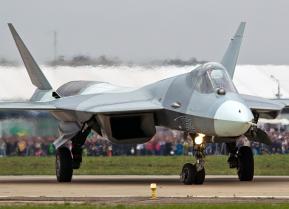The 1 Reason Russia's Su-57 Fighter Is No Game Changer
The Su-57 is beautiful. It's also too expensive for Russia to buy in meaningful numbers.
Key point: A fancy photo shoot can't reverse an economic slump, nor can it magically conjure hundreds of new stealth fighters. Russia's Su-57 might be a media star. But it's on track to play no meaningful role in Moscow's military strategy.
The Russian defense ministry staged an impressive video shoot with four of its Su-57 stealth fighter prototypes. But the dramatic display doesn't make the Su-57 any more relevant.
The Su-57 is beautiful. It's also too expensive for Russia to buy in meaningful numbers.
In the November 2018 videos, produced by the Kremlin's Zvezda T.V., four of the twin-engine Su-57s fly in close formation with the An-12 photo plane. Two of the radar-evading prototypes land at the same time. A single Su-57 performs a flat spin.
The four Su-57s in the video account for nearly half of the 10 of stealth fighters the Russian air force has acquired since the type first flew in 2010. Two Su-57s briefly deployed to Syria in February 2018. The Kremlin claimed, without firm proof, that the planes flew strike missions during the deployment.
The Kremlin ordered its first dozen production-standard Su-57s in August 2018, hoping to form the first regular squadron some time in 2019. With military budgets declining amid an economic slump, Moscow decided to not acquire the plane in large numbers.
It's unclear how much the Su-57's development has cost so far, how much the program would need to complete development and how much each production-standard plane would set back Russian taxpayers. The U.S. military spent more than $60 billion acquiring around 180 F-22s and expects to spend $400 billion buying some 2,300 F-35s.
The Russian government tried to spin the decision to curtail the Su-57 effort. “You know that today the Su-57 is considered to be one of the best aircraft produced in the world,” Yuri Borisov, Russia’s deputy defense minister, told a T.V. audience in July 2018. “Consequently, it does not make sense to speed up work on mass-producing the fifth-generation aircraft.”
Time is running out for the Russian air force to integrate the Su-57 into its force structure. The "fifth-generation" stealth fighter began development in the early 2000s, but its fortunes are tied to the Kremlin's 2009 defense strategy, which aimed to reverse years of budget cuts and declining military readiness.
In May 2009, Dmitriy Medvedev, then Russia's president, announced a new national security strategy through the year 2020. The strategy praised former, and future, president Vladimir Putin for leading Russia out of its "political and socio-economic systemic crisis" and anticipated that Russia would "consolidate its influence in the world arena" as a leading political and economic power.
"Unprecedented" new spending backed up the new strategy, according to the 2017 edition of the International Institute for Strategic Studies' "The Military Balance" report. "The proportion of military spending increased when measure against GDP, placing Russia in a small group of nations spending over five percent of GDP on defense."
"After almost two decades of deterioration and neglect of the Russian military, Moscow began developing a more modern military force capable of power projection outside Russia’s borders," the U.S. Defense Intelligence Agency reported in 2017.
The spending supported five fighter production lines -- one producing the Su-57, three making variants of the Su-27 including the Su-30, the Su-34 and the Su-35 and a fifth manufacturing versions of the MiG-29. Russian air arms received around 200 new and upgraded aircraft in 2017 and around another 100 in 2018. By comparison, the U.S. armed forces ordered more than 400 new aircraft in 2018.
An economic downturn, which shaved nearly four percent off of GDP in 2015, forced Moscow to reconsider its priorities. "In preparing the 2016 budget, there was clearly awareness that this level of spending could not be sustained," IISS reported.
A few years of higher spending had a dramatic effect on the Russian air force. "Substantial deliveries of new frontline aircraft, and their intensive use in Syria, have given the Russian air force an entirely new public face in a short period of time," analyst Keir Giles wrote in a 2017 report for the Carnegie Endowment for International Peace.
"Optimistic Russian commentators, comparing their air power specifically with that of the United States, note approximate quantitative parity with the U.S. Air Force," Giles continued.
In fact, the DIA estimated in 2017 that Russian air arms maintained just 1,000 tactical aircraft. At the same time, the U.S. Air Force, Navy and Marine Corps between them possessed more than 3,000 fighters.
To support the 2009 strategy, the Kremlin needed to acquire 1,000 new airplanes and helicopters by 2020, the DIA estimated. Deepening budget cuts could force the Russian armed forces to make do with far fewer new aircraft, and just a dozen Su-57s.
In contrast, in 2018 the Americans operated several hundred F-22 and F-35 fifth-generation stealth fighters, with many more F-35s on order or in production. "Western air power experts ... note that Russia’s lack of fifth-generation aircraft, especially with their ability to provide situational awareness to friendly forces, constitutes a critical capability gap," Giles noted.
A fancy photo shoot can't reverse an economic slump, nor can it magically conjure hundreds of new stealth fighters. Russia's Su-57 might be a media star. But it's on track to play no meaningful role in Moscow's military strategy.
David Axe edits War Is Boring . He is the author of the new graphic novels MACHETE SQUAD and THE STAN.
Image: Creative Commons.


